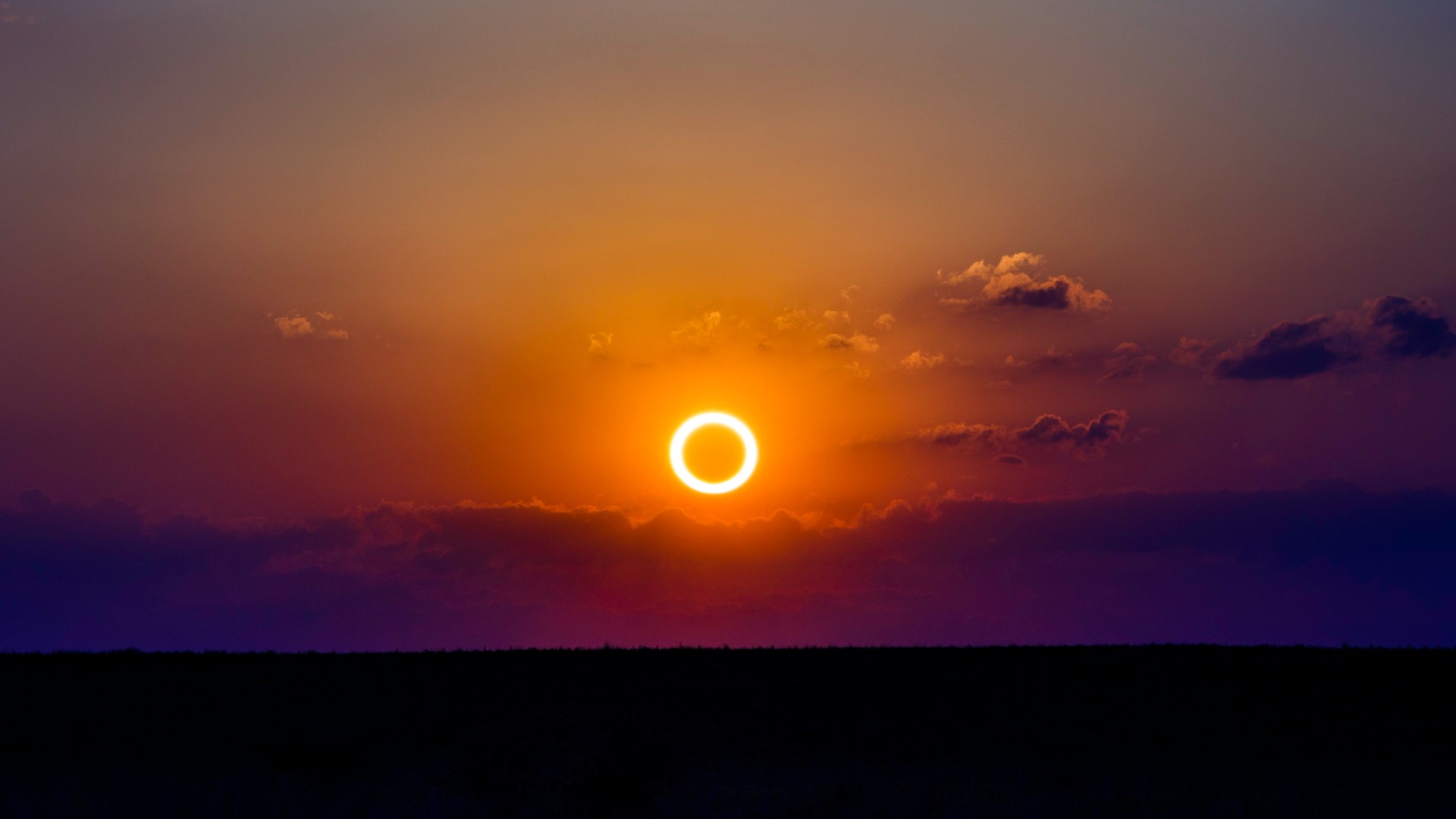'Ring of fire' eclipse Oct. 14 will be practice run for total solar eclipse next year
The world's biggest solar telescope will join the observing party.

Scientists in the United States are excited to use the October "ring of fire" eclipse as valuable practice for a total eclipse in the Americas next year.
North America will experience an annular "ring of fire" solar eclipse on Oct. 14 that crosses eight U.S. states in between Oregon and Texas. We have full details about how to watch in-person and online here, including selecting the right equipment to observe the sun safely.
An annular eclipse occurs when the moon is further away from Earth, causing it to be slightly smaller than the sun in the sky. The smaller moon is unable to block the entire disk of the sun, creating a "ring of fire" for a few minutes when the moon passes in front of the sun.
To share details about the eclipse science projects they have planned, representatives from the National Science Foundation (NSF) spoke with media during an online briefing Wednesday (Oct. 4) not only about the upcoming annular eclipse, but also the total solar eclipse that passes across the United States on April 8, 2024. You can get viewing details for totality here at Space.com as well.
Related: Which U.S. states will October's 'ring of fire' solar eclipse be visible from?

If you're looking for safe optics to view the eclipse, we recommend the Celestron EclipSmart 2x Power Viewers, which have 2x magnification or this travel-friendly solar telescope. You can also consult our guide to photographing the solar eclipse.
NSF plans annular eclipse outreach events in both the Albuquerque, New Mexico and Boulder, Colorado areas, including partnerships with NASA, the National Oceanic and Atmospheric Administration (NOAA), the University of Colorado's Fiske Planetarium, Albuquerque's International Balloon Fiesta and the New Mexico Museum of Natural History and Science that will bring in thousands of members of the public.
Science will be front and center as well, with the research team using the annular eclipse to get ready for totality. For example, the Daniel K. Inouye Solar Telescope at the National Solar Observatory in Maui, Hawaii will be entering its operational phase just in time for both eclipses, according to Carrie Black, a program officer at NSF's astronautical science division that oversees Inouye's operations.
Get the Space.com Newsletter
Breaking space news, the latest updates on rocket launches, skywatching events and more!
Inouye, the world's largest solar telescope, will not be in the eclipse path during either October 2023's or April 2024's events. But Inouye will provide a high-resolution "unobstructed view of the sun while the eclipse is happening," Black said. Inouye's results can then be compared with other telescopes to get a fuller picture of solar activity and its effects on Earth, particularly with the sun at a height of solar activity.
"It's like a microscope," Black said of the powerful Inouye, "essentially to zoom in and look at features we wouldn't be able to see otherwise without this type of high resolution — and then connecting it to other (telescope) observations."
Related: See amazing new sun photos from the world's largest solar telescope
Scientists generally, said NSF's Lisa Winter, will be able to view a very active corona — or upper atmosphere of the sun — during the precious minutes that the sun is nearly completely blocked by the moon. The sun is nearing its maximum of solar activity in its 11-year-cycle, unlike the last U.S. total solar eclipse of 2017, meaning that "the corona will be very active this time around," said Winter, who is NSF's program director for solar-terrestrial research.
Solar activity has an immense impact on the ionosphere, which is a layer of Earth's atmosphere that interacts with electromagnetic radiation from above and below its extent. These interactions affect the propagation of radio signals.
With the sun mostly blacked out temporarily by the eclipse, NSF will be carefully watching what happens "when you suddenly turn off that X-ray and the ultraviolet" rays from the sun that usually filter into the ionosphere and affect its extent, said Mangala Sharma, the foundation's program director for space weather (the ionosphere actually expands and contracts depending on how much energy it is absorbing from the sun)
The ham radio community will also help with ionospheric studies during the eclipse, using their GPS receivers to help professional scientists track changes in that layer of the Earth's atmosphere. "That's going to be useful in moving the science forward, and also getting the excitement of the eclipse out into the public," Sharma said.
Additionally, scientists will be watching local weather to see how it is affected by the lack of solar radiation. "The moon's shadow traverses across the atmosphere at supersonic speeds, so things change pretty fast (and) very quickly throughout the eclipse region," Sharma said.
In April next year, scientists will chase the total eclipse in NSF/National Center for Atmospheric Research Gulfstream-V aircraft to study the elusive "low corona," referring to the parts of the upper atmosphere of the sun that are not observable from space.
Black called the experience of seeing this low corona "magical" – so much so that scientists "spend their whole careers traveling around the world to try to find these total solar eclipses, so that you can see this (low) region that we're particularly interested in."
Once this eclipse campaign is over, NSF says no other total solar eclipse will be visible in the United States until 2044 — that's 20 years after April's event.
Join our Space Forums to keep talking space on the latest missions, night sky and more! And if you have a news tip, correction or comment, let us know at: community@space.com.

Elizabeth Howell (she/her), Ph.D., was a staff writer in the spaceflight channel between 2022 and 2024 specializing in Canadian space news. She was contributing writer for Space.com for 10 years from 2012 to 2024. Elizabeth's reporting includes multiple exclusives with the White House, leading world coverage about a lost-and-found space tomato on the International Space Station, witnessing five human spaceflight launches on two continents, flying parabolic, working inside a spacesuit, and participating in a simulated Mars mission. Her latest book, "Why Am I Taller?" (ECW Press, 2022) is co-written with astronaut Dave Williams.









